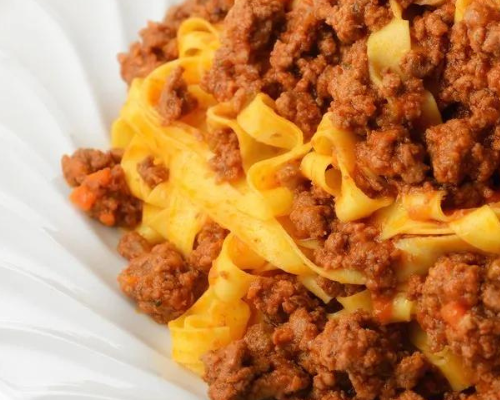Sugo all’Amatriciana, also known simply as Amatriciana sauce, is a beloved Italian pasta sauce with roots tracing back to the town of Amatrice in the Lazio region of central Italy. This iconic sauce is renowned for its rich, savory flavors and has become a staple in Roman and Italian cuisine. Let’s explore the fascinating history, development, and traditional preparation of this classic dish.
History and Heritage
The origins of Sugo all’Amatriciana can be traced back to the 18th century in the town of Amatrice, nestled in the Apennine Mountains. Originally, the sauce was a humble creation of shepherds who used local ingredients—cured pork cheek (guanciale), pecorino cheese, and tomatoes—to prepare a hearty meal in the fields. Over time, the sauce gained popularity and made its way to the bustling kitchens of Rome, where it became a celebrated dish.
Development and Variants
The traditional recipe for Sugo all’Amatriciana includes a few key ingredients: guanciale (or sometimes pancetta), tomatoes, Pecorino Romano cheese, and chili peppers. The sauce is known for its simplicity and depth of flavor. Variations of the sauce may include garlic, onions, or white wine, but purists argue that the authentic Amatriciana should remain true to its rustic origins.
Pasta Shapes and Pairings
Sugo all’Amatriciana is typically paired with pasta shapes that can hold the hearty sauce, allowing every bite to be a burst of flavor. The most common pasta shapes used with Amatriciana sauce are bucatini—a thick, hollow spaghetti-like pasta—spaghetti, or rigatoni. These pasta shapes complement the robust nature of the sauce, allowing it to cling to the ridges and crevices.
Conclusion
Sugo all’Amatriciana embodies the rustic flavors and culinary heritage of central Italy. This timeless pasta dish, with its savory guanciale, tangy tomatoes, and spicy kick, continues to captivate food enthusiasts around the world. Whether enjoyed in the heart of Rome or prepared at home, Sugo all’Amatriciana invites you to savor the essence of Italian tradition in every mouthful.
- 400 gram Tomato canned, peeled and crushed
- 150 gram Guanciale seasoned and diced
- 50 gram Pecorino Romano grated
- 2 piece Chili Peppers red and thinly sliced
- 30 ml Olive Oil Extra Virgin
- t.t Sea Salt
In a large pan add diced Guanciale and sauté until golden and crispy.
Remove the golden crispy Guanciale and set aside. Keep the released fat from the Guanciale in the pan.
Heat olive oil in a new large skillet over medium heat.
Add sliced chili peppers to the skillet and cook briefly.
Pour in the crushed tomatoes and season with salt to taste.
Simmer the sauce for about 15-20 minutes, stirring occasionally.
Bring a large pot of salted water to a boil.
Cook the bucatini or spaghetti according to package instructions until al dente.
Reserve about 1 cup (250ml) of pasta cooking water, then drain the pasta..
Heat up the pan with the Guanciale fat and add the cooked pasta to the skillet with the Amatriciana sauce.
Toss the pasta untill evenly coated with the Guanciale fat.
Add the cooked pasta to the pan with the Amatriciana sauce.
Toss well to coat the pasta evenly with the sauce.
If needed, add a splash of reserved pasta water to loosen the sauce.
Divide the pasta with Amatriciana sauce into bowls or plates.
Garnish generously with grated Pecorino Romano cheese and the golden crispy Guanciale cubes.
Enjoy this classic Roman dish with a glass of Italian red wine.



